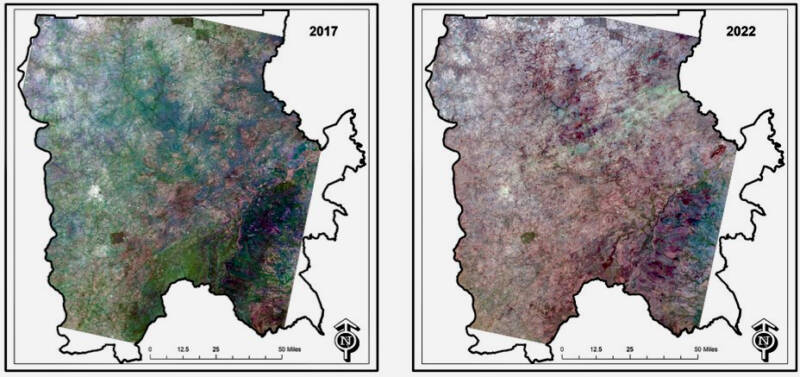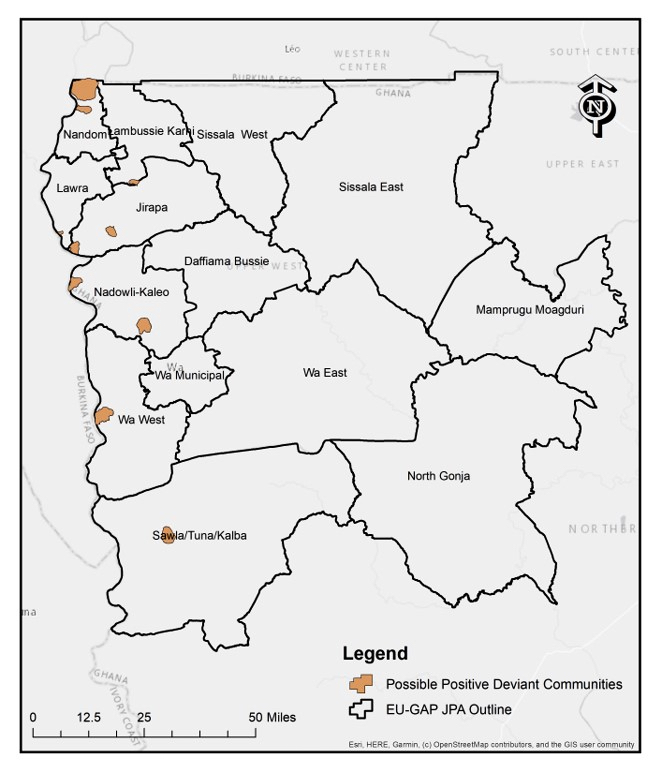How Remote Sensing Can Help Save Ghana’s Trees
Using remote sensing to preserve trees and combat climate change

The Added Value of This Article
Hover over to have a look!Value add for readers
- Gain insight into innovative approaches. Explore the use of remote sensing and positive deviance in preserving tree covers, providing effective strategies for addressing climate change challenges.
- Learn practical learnings: Get first-hand experiences and approaches from real-world training, enabling the application of remote sensing data and participatory decision-making in development projects.
Analysis showing the change in vegetative coverfrom 2017 to 2022
Climate change poses great challenges for rural communities in the North of Ghana. Due to their dependence on climate-sensitive sectors like agriculture, forestry, and natural resource management, they are highly vulnerable to the effects of climate change. In order to reduce their vulnerabilities, adaptation measures that enhance resilience and cope with climate change impacts are crucial.
This article explores the benefits of new approaches, particularly the utilization of remote sensing data and the Data-Powered Positive Deviance method, in preserving Ghana’s trees and empowering local communities.
Benefits of the Data Powered Positive Deviance Method
Adaptation measures in rural agrarian areas rely on behavioral changes within communities, utilizing collective wisdom and lived experiences for sustainable outcomes and social acceptance.
Community-identified adaptation measures are sustainable since it capitalizes on local knowledge, resources, and local dynamics and governance for implementation with less reliance on aid, external expertise, and government support. Implementation of the defined measures enhances the community’s shared responsibility for resilience and a belief in their ability to succeed.
To identify community-led approaches the novel method of data-powered positive deviance was developed in 2019. It approaches the subject by asking: What can we learn from outliers? What information can we get from people who do things differently?
The Positive Deviance Collaborative defines positive deviance as “based on the observation that in every community there are certain individuals or groups whose uncommon behaviours and strategies enable them to find better solutions to problems than their peers — while having access to the same resources and facing similar or worse challenges.”
In our case we wanted to investigate how communities manage tree covers, trying to identify those who preserve or increase their tree covers in the community – contrary to common observations
In a training organized through SNRD Africa, Asia and giz data lab we gained first-hand experience and would like to share our learnings and approaches with you. The question was what do communities do differently to sustain tree cover?
Stage 1: Assess Problem-Method Fit
The tree cover in northern Ghana is under threat. Forests and trees are disappearing. The reasons are manifold: bushfires, changed land use, such as for agriculture, dwelling and animal rearing and herding as well as the increased need for firewood among others.
For rural and vulnerable communities, sufficient tree cover is however necessary for economic activities in the North (such as the production of shea butter, and sustainable wood use) and it protects from floods and droughts.
In northern Ghana, 97.9% of the households are engaged in crop farming, with few in other forms of farming including poultry and livestock. Agricultural production is the main activity, practiced mainly on seasonal and subsistence levels. The sector remains the largest source of employment with many being smallholder farmers.
In the dry season, charcoal burning becomes an alternative livelihood strategy and support system. There is demand for the sale since charcoal provides about 64% of domestic energy requirements in Ghana. In addition to other factors such as security and bad farming practices, tree cover is at risk. Deforestation is rising.
This notwithstanding, the assessment of the suitability of the application of the DPPD (Data Powered Positive Deviance) methodology, it was realized that amidst these trends, positive deviants (communities preserving their tree cover) exist and the identification and scaling up of the practices could significantly impact discussions on resilience among communities.
On feasibility, the capturing of the contextual reality of the target group is based on traditional and non-traditional data. Data from statistical services and municipal and district assemblies aided in the identification of homogeneous communities used at target groups. The use of satellite images normalized differential vegetation index, and change detections together with surveys aids in the derivation of outcome data. The methodology is desirable since positive deviant communities may have some advantage in being resilient as compared to the others.
Stage 2: Determine Positive Deviant
Earth observation through satellite data was used to measure the performance of the communities in the project area with normalized difference vegetation index as the observed outcome measure.
From the workflow LANDSAT data attained from USGS (United States Geological Survey) was used for this work. Band combination was carried out to achieve a composite band image for further analyses. The Normalized Difference Vegetation Index was used to ascertain tree cover for 2017 and 2022. The change detection algorithm in Erdas Imagine 2015 was applied to assess changes in the tree cover in the two images. The output was 5 classes based on 10% changes in pixel values, thus, decreased, some decreased, unchanged, some increase, and some increased. The areas where there have been some decreases and decreases were taken as the normal expected outcome in the study.
Positive deviants were determined were areas remained unchanged or with an increase in tree cover. Thus, communities that had their tree cover maintained and or had some increase up to 10% over the 5 years. The community resource extents for 48 rural communities in the project area were overlaid on the output of the satellite image analyses. Based on the spatial location selection algorithm and ranking per aggregation, 10 communities were identified as possible positive deviants.
Stage 3: Discover Underlying Factors
The current stage of the Data Powered Positive Deviance methodology
The team is presently at this stage of the Data-Powered Positive Deviance methodology. Thus, unearthing the underlying factors to the maintaining and increase in tree cover amidst diverse factors contributing to deforestation in the project area.
Initial hypotheses are strong bylaws, a strong perception of climate risks and how tree cover is connected, and available water sources, among others.
By understanding these factors, communities can adopt effective adaptation strategies.
Possible deviant communities which are currently being reviewed
Background of the Project
The Resilience Against Climate Change project aims to build resilience in 200 rural communities across 14 districts in North Ghana. Through participatory community action planning and the adoption of conservation agriculture, the project empowers 200 rural communities to identify and implement locally appropriate adaptation strategies.
Utilizing land use maps generated through joint efforts, communities develop climate-resilient action plans. Remote sensing and the Data-Powered Positive Deviance method play a critical role in facilitating community engagement, knowledge sharing, participatory decision-making processes and adaptation strategies that make sense in the particular setting.
To sum it up
Remote sensing and the Data-Powered Positive Deviance method offer valuable tools for preserving tree covers and combating climate change in Ghana’s rural communities. By harnessing the power of local knowledge and data-driven approaches, communities can develop sustainable adaptation strategies that enhance resilience and reduce reliance on external support. The ongoing efforts in Ghana serve as an example of how remote sensing can contribute to the preservation of natural resources and the well-being of vulnerable communities worldwide.
Additional information on the Data Powered Positive Deviance method
Data-Powered Positive Deviance for Climate Change Mitigation (GIZ internal only)
An excellent overview by one of the founders of the Data Powered Positive Deviance method, Basma Albanna:
Authors
The article has been submitted by Anthony Sarfo, Technical Advisor GIS, and Joy Heitlinger, Technical Advisor Production.


